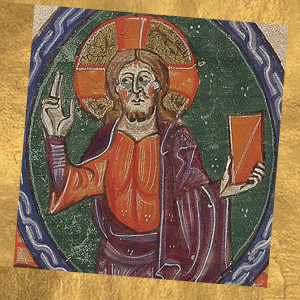Sts. John de Brébeuf and Isaac Jogues, priests and Companions, Jesuits, Canadian Martyrs - Information on the Saint of the Day
Among the Hurons
When the Jesuits in France decided to begin a mission to bring the Word of God to the indigenous peoples of New France, or present-day Canada, the newly ordained Fr. Jean de Brébeuf (b. 1593 – d. 1649) was ready. Already in his youth, he had made a vow never to refuse martyrdom if it came; and he knew that in this distant land full of vast forests, snow and warring tribes, it might come. He arrived in the territory of the Huron (Wendat) people in 1626. For twenty years he labored among this people, living with them, compiling the first dictionary of their language, and writing a catechism in Wendat. Echon, or “he who carries a heavy load,” the Hurons called him. Some of them accepted baptism.
Gradually, others joined the mission: the Jesuits Fr. Isaac Jogues (b. 1607–d. 1646), Fr. Gabriel Lalement (b. 1610–d. 1649); Fr. Antoine Daniel (b. 1601–d. 1648); Fr. Charles Garnier (b. 1606–d. 1649); Fr. Noël Chabanel (b. 1616–d. 1649); the deaf lay brother René Goupil (b. 1609-d. 1642); and layman Jean de la Lande (d. 1646).
Ossernenon
The Iroquois Confederacy was at war with the Hurons and saw the French missionaries as allies of their enemies. In 1642, an Iroquois war party captured Fr. Isaac Jogues and René Goupil, taking them to the Mohawk village of Ossernenon (present-day Auriesville, New York). There Fr. Jogues was tortured, several of his fingers cut off so that he could not celebrate Mass, and Goupil was killed. Fr. Jogues was a slave for over a year, but eventually was ransomed and returned to France, where he received a dispensation allowing him to celebrate Mass with mutilated hands. Torture could not dissuade him from the mission, however, and he returned to New France.
In 1646, Fr. Jogues returned to Ossernenon with Jean de la Lande, attempting to negotiate a peace treaty; both were captured and killed.
“My strength is the strength of God”
Fr. Antoine Daniel, who had a gift for teaching Huron children and for music, was next: in 1648, Iroquois warriors attacked the Huron village near Québec where he had a small church. Some of the Huron Christians hid inside the church while he stood outside to confront the attackers. He was killed. It is said that he was thrown inside the church, which was set on fire, to burn with his flock.
Frs. Jean de Brébeuf and Gabriel Lalemant were kidnapped in the present-day province of Québec the following year, after managing to warn some of the Huron villagers that enemy warriors were near. The martyrdom that Fr. de Brébeuf had vowed not to escape had come, and it was interminable. The two were made to run the gauntlet, were tied to crosses, “baptized” with boiling water and slashed with knives. Throughout the ordeal, Fr. de Brébeuf in particular prayed for the courage to suffer without crying out, for the sake of the warriors inflicting these sufferings. They valued courage, and he did not want them to think that Christians were weak. So impressed were they that when he died, they ate his heart so as to obtain a share in his bravery.
Fr. Lalement had to watch as his confrere was killed first. “My strength is the strength of God,” he had once written, and this strength carried him through to the end.
Frs. Charles Garnier and Noël Chabanel were killed later in the same year.
The seed of the Church
These eight deaths seemed like brutal failure after the sacrifices these men had endured for the mission. But God does not see as man sees. Later, Isaac Jogues’ killer would ask for baptism. And in Ossernenon, the same village where Isaac Jogues, René Goupil and Jean de la Lande were killed, Kateri Tekakwitha, a Mohawk who became the first Native American saint, would be born only ten years later. Today, the Church in North America acknowledges these eight men as the small, suffering seed from which it sprang.







